Visions of the Daughters of Albion is a 1793 poem by William Blake, produced as a book with his own illustrations. It is a short and early example of his prophetic books, and a sequel of sorts to The Book of Thel .
Contents

Visions of the Daughters of Albion is a 1793 poem by William Blake, produced as a book with his own illustrations. It is a short and early example of his prophetic books, and a sequel of sorts to The Book of Thel .

The central narrative is of the female character Oothoon, called the "soft soul of America", and of her sexual experience. S. Foster Damon (A Blake Dictionary) suggested that Blake had been influenced by Mary Wollstonecraft's A Vindication of the Rights of Woman , published in 1792.
Oothoon is in love with Theotormon, who represents the chaste man, filled with a false sense of righteousness. Oothoon desires Theotormon but is suddenly, violently raped by Bromion. After Oothoon is raped neither Bromion nor Theotormon want anything to do with her.
As is usual in Blake, the names of the characters represent their symbolic roles. Theotormon's name is derived from the Greek theos, which means "god", and the Latin tormentum, which means "twist" or "torment". The name of his rival Bromion is Greek meaning "roarer".
Bromion represents the passionate man, filled with lustful fire. Oothoon is the representation of a woman in Blake's society, who had no charge over her own sexuality. Blake has the Daughters of Albion look to the West, to America, because he believed that there was a promise in America that would one day end all forms of discrimination. It was to be in America, that races would live in harmony, and women would be able to claim their own sexuality. At the same time, Blake recognizes that though America has freed itself from British rule, it continues to practice slavery.
Blake used Plato's Allegory of the Cave in Visions of the Daughters of Albion as a theme for the three characters not being able to understand the true nature of reality, without being hindered by convention. It has been argued that Theotormon is a mythicised version of John Stedman, whose book about his experience of slavery and brutality in Suriname on the coast of South America was being illustrated by Blake at the time. [1]
![]() Media related to Visions of the Daughters of Albion at Wikimedia Commons
Media related to Visions of the Daughters of Albion at Wikimedia Commons

William Blake was an English poet, painter, and printmaker. Largely unrecognised during his life, Blake is now considered a seminal figure in the history of the poetry and visual art of the Romantic Age. What he called his "prophetic works" were said by 20th-century critic Northrop Frye to form "what is in proportion to its merits the least read body of poetry in the English language". His visual artistry led 21st-century critic Jonathan Jones to proclaim him "far and away the greatest artist Britain has ever produced". In 2002, Blake was placed at number 38 in the BBC's poll of the 100 Greatest Britons. While he lived in London his entire life, except for three years spent in Felpham, he produced a diverse and symbolically rich collection of works, which embraced the imagination as "the body of God" or "human existence itself".
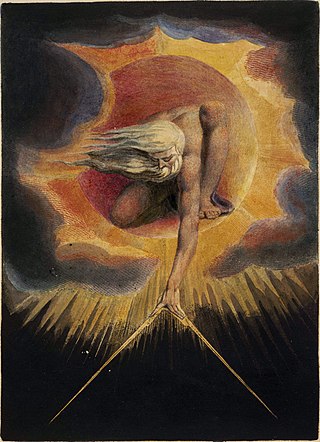
In the mythology of William Blake, Urizen is the embodiment of conventional reason and law. He is usually depicted as a bearded old man; he sometimes bears architect's tools, to create and constrain the universe; or nets, with which he ensnares people in webs of law and conventional society. Originally, Urizen represented one half of a two-part system, with him representing reason and Los, his opposition, representing imagination. In Blake's reworking of his mythic system, Urizen is one of the four Zoas that result from the division of the primordial man, Albion, and he continues to represent reason. He has an Emanation, or paired female equivalent, Ahania, who stands for Pleasure. In Blake's myth, Urizen is joined by many daughters with three representing aspects of the body. He is also joined by many sons, with four representing the four elements. These sons join in rebellion against their father but are later united in the Last Judgment. In many of Blake's books, Urizen is seen with four books that represent the various laws that he places upon humanity.

Free love is a social movement that accepts all forms of love. The movement's initial goal was to separate the state from sexual and romantic matters such as marriage, birth control, and adultery. It stated that such issues were the concern of the people involved and no one else. The movement began around the 19th century and was advanced by hippies during the Sixties.
The prophetic books of the English poet and artist William Blake contain an invented mythology, in which Blake worked to encode his spiritual and political ideas into a prophecy for a new age. This desire to recreate the cosmos is the heart of his work and his psychology. His myths often described the struggle between enlightenment and free love on the one hand, and restrictive education and morals on the other.

Orc is a proper name for one of the characters in the complex mythology of William Blake. A fallen figure, Orc is the embodiment of rebellion, and stands opposed to Urizen, the embodiment of tradition.

Jerusalem: The Emanation of the Giant Albion is a prophetic book by English poet William Blake. Jerusalem is the last, longest and greatest in scope of Blake's works. Etched in handwriting, accompanied by small sketches, marginal figures and huge full-plate illustrations, it has been described as "visionary theatre". The poet himself believed it was his masterpiece and it has been said that "of all Blake's illuminated epics, this is by far the most public and accessible". Nonetheless, only six copies were printed in Blake's lifetime and the book, like all of Blake's prophetic works, was all but ignored by his contemporaries.

The Book of Thel is a poem by William Blake, dated 1789 and probably composed in the period 1788 to 1790. It is illustrated by his own plates, and compared to his later prophetic books is relatively short and easier to understand. The metre is a fourteen-syllable line. It was preceded by Tiriel, which Blake left in manuscript. A few lines from Tiriel were incorporated into The Book of Thel. Most of the poem is in unrhymed verse.

The prophetic books of the 18th-century English poet and artist William Blake are a series of lengthy, interrelated poetic works drawing upon Blake's own personal mythology. They have been described as forming "what is in proportion to its merits the least read body of poetry in the English language". While Blake worked as a commercial illustrator, these books were ones that he produced, with his own engravings, as an extended and largely private project.

Enitharmon is a major female character in William Blake's mythology, playing a main part in some of his prophetic books. She is, but not directly, an aspect of the male Urthona, one of the Four Zoas. She is in fact the Emanation of Los, also male. There is a complex verbal nexus attached. The Zoa Tharmas has emanation Enion, and Eni-tharm(as)-on is one derivation of her name. That should perhaps be read in the inverse direction though, as a construction of the Tharmas/Enion pair's names. Within Blake's myth, she represents female domination and sexual restraints that limit the artistic imagination. She, with Los, gives birth to various children, including Orc.
Har is a character in the mythological writings of William Blake, who roughly corresponds to an aged Adam. His wife, Heva, corresponds to Eve. Har appears in Tiriel (1789) and The Song of Los (1795) and is briefly mentioned in The Book of Thel (1790) and Vala, or The Four Zoas (1796-1803).
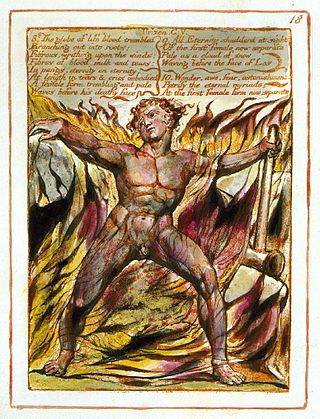
In the mythological writings of William Blake, Los is the fallen form of Urthona, one of the four Zoas, and the embodiment of human creativity and inspiration. He is referred to as the "eternal prophet" and creates the visionary city of Golgonooza. Los is regularly described as a smith, beating with his hammer on a forge, which is metaphorically connected to the beating of the human heart. The bellows of his forge are the human lungs. Los's emanation, Enitharmon, represents spiritual beauty and embodies pity, but at the same time creates the spatial aspect of the fallen world, weaving bodies for men and creating sexual strife through her insistence upon chastity. In the Book of Urizen (1794), Los and Enitharmon have a child, Orc, who is the embodiment of the spirit of revolution. The name Los is, by common critical acceptance, an anagram of Sol, the Latin word for "sun". Los is also the plural form of El, an ancient Hebrew deity. Such innovations are common in many of Blake's prophetic poems.
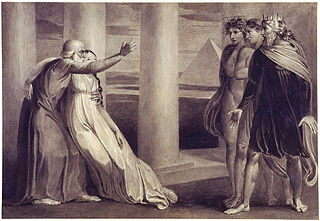
Tiriel is a narrative poem by William Blake, written c.1789. Considered the first of his prophetic books, it is also the first poem in which Blake used free septenaries, which he would go on to use in much of his later verse. Tiriel was unpublished during Blake's lifetime and remained so until 1874, when it appeared in William Michael Rossetti's Poetical Works of William Blake. Although Blake did not engrave the poem, he did make twelve sepia drawings to accompany the rough and unfinished manuscript, although three of them are considered lost as they have not been traced since 1863.
Leutha is a female character appearing in the mythology of William Blake. According to S. Foster Damon, A Blake Dictionary, she stands for 'sex under law'.
Bromion is a character in the mythology of William Blake. According to S. Foster Damon he represents Reason, from the side of the poet's mind.
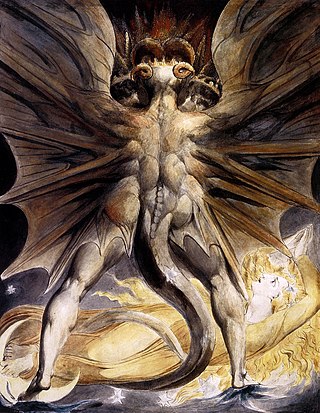
William Blake's body of work has influenced countless writers, poets and painters, and his legacy is often apparent in modern popular culture. His artistic endeavours, which included songwriting in addition to writing, etching and painting, often espoused a sexual and imaginative freedom that has made him a uniquely influential figure, especially since the 1960s. After Shakespeare, far more than any other canonical writer, his songs have been set and adapted by popular musicians including U2, Jah Wobble, Tangerine Dream, Bruce Dickinson and Ulver. Folk musicians, such as M. Ward, have adapted or incorporated portions of his work in their music, and figures such as Bob Dylan, Alasdair Gray and Allen Ginsberg have been influenced by him. The genre of the graphic novel traces its origins to Blake's etched songs and Prophetic Books, as does the genre of fantasy art.

Vala, or The Four Zoas is one of the uncompleted prophetic books by the English poet William Blake, begun in 1797. The eponymous main characters of the book are the Four Zoas, who were created by the fall of Albion in Blake's mythology. It consists of nine books, referred to as "nights". These outline the interactions of the Zoas, their fallen forms and their Emanations. Blake intended the book to be a summation of his mythic universe but, dissatisfied, he abandoned the effort in 1807, leaving the poem in a rough draft and its engraving unfinished. The text of the poem was first published, with only a small portion of the accompanying illustrations, in 1893, by the Irish poet W. B. Yeats and his collaborator, the English writer and poet Edwin John Ellis, in their three-volume book The Works of William Blake.

America a Prophecy is a 1793 prophetic book by the English poet and illustrator William Blake. It is engraved on eighteen plates, and survives in fourteen known copies. It is the first of Blake's Continental prophecies.

The French Revolution is a poem written by William Blake in 1791. It was intended to be seven books in length, but only one book survives. In that book, Blake describes the problems of the French monarchy and seeks the destruction of the Bastille in the name of Freedom.
In the mythological writings of William Blake, Enion is an Emanation/mate of Tharmas, one of the four Zoas, who were created when Albion, the primordial man, was divided fourfold. She represents sexuality and sexual urges while Tharmas represents sensation. In her fallen aspect, she is a wailing woman that is filled with jealousy. After the Final Judgment, she is reunited with Tharmas and able to experience an idealised sexual union.
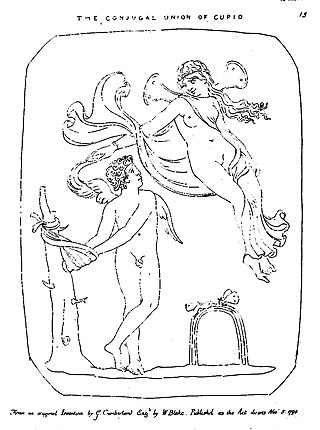
George Cumberland was an English art collector, writer and poet. He was a lifelong friend and supporter of William Blake, and like him was an experimental printmaker. He was also an amateur watercolourist, and one of the earliest members of the Bristol School of artists. He made use of his wide circle of connections to help its other members, in particular assisting and influencing Edward Bird and Francis Danby.